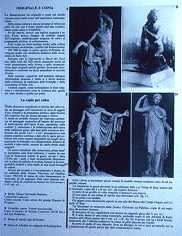The Modern Copying Process
 |

|
 |
Originals and Copies
In the classical world, the demarcation between originals and copies was not as strict as it is today.Our culture tends to devalue art that is not the direct product of a creative act intended to be unique and unrepeatable.
For the ancients, on the other hand, a replica executed as a work of art could function as an exact duplicate of the original, fulfilling the needs of cult, political propaganda, and art collecting.
Beginning in the Renaissance, replicas played an analogous role in postclassical Western culture.
In the 17th century, thanks to Bernini, plaster casts also became a didactic tool in academies of fine art.
Thus were born the collections and museums of plaster casts that, from the mid-19th century on, also played an important role in art historical research and the reconstruction of lost ancient sculptures, facilitating comparisons between pieces dispersed among widely separated collections.
We have little hard information about the techniques of ancient copyists, but much can be deduced from the continuity of technical traditions in workshops and art academies.
As literary sources and archaeological discoveries attest, there are essentially two copying techniques: replication through direct impression or the pointing process.
Copying through Molds and Casts
We are accustomed to thinking of casts in the context of the mass production of crafts or utilitarian objects, from lamps to fine china with relief decoration.In actuality, the cast obtained through direct impression can be an essential step in the creation of a work of art, especially in the case of sculpture. The imitation and adaptation of classical Greek sculptures that characterized much of the output of Roman sculptors in the first centuries BC/AD were predicated upon a continuous copyist tradition. Because the most famous statues were not always available in the places where Roman sculptural workshops operated, three-dimensional casts produced from molds fabricated directly from esteemed works of art were indispensable.
A series of ancient plaster fragments discovered at Baiae in 1954 made an important new contribution to our knowledge of ancient copying techniques, which was previously based primarily on literary sources. It has recently been demonstrated that the Baiae fragments represent plaster casts of famous bronze sculptures, probably used as three-dimensional models in a local workshop of copyists.
Still more recently (1981-82), fragmentary terracotta cult statues of the Augustan period were uncovered in excavations near the Palace of Tiberius on the Palatine Hill in Rome. These terracotta sculptures were fashioned from molds of bronze Greek originals that date to the fifth and fourth centuries BC.
Illustrations
- Rome. Museo Nazionale Romano. Ludovisi Collection.
Gaul Committing Suicide. Ancient copy of the Great Donarium of Pergamum. - Versailles, Park. Crouching Venus.
Bronze copy by Antoine Coysevox (17th century) of the Aphrodite of Doidalsos. - Statue of the Apollo Belvedere.
- Statue of Aphrodite after the original by Kallimachos.



